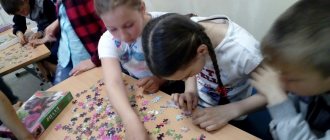Your own system operator
TRIZ technology method “System Operator” as a means of developing the creative initiative of a preschooler
Humanization, socialization, individualization are the basic principles enshrined in regulatory documents on preschool education. One of the primary tasks of education and training, according to the Federal State Educational Standard for Education, is raising a generation of children with high creative potential. But the problem is not the search for gifted, brilliant children, but the purposeful formation of creative abilities, the development of a non-standard vision of the world, new thinking in all children.
It is the TRIZ-RTV technology that most fully allows the teacher to implement these most important principles in a form that is accessible and interesting for children: teaching children how to independently obtain information is possible through search activities, and through organized collective reasoning, and through games and trainings. Therefore, TRIZ can be called a school of creative personality. My work experience has shown that the use of TRIZ elements in the development of preschool children radically changes the teacher’s work style, liberates children, teaches them to think and look for solutions to problems.
I have tried several methods and techniques known in TRIZ technology, I often use them, but I especially like working using the “System Operator” method. I set myself the task of teaching children to think in large categories with the help of a “system operator”, using tables and diagrams, to develop an understanding of the structure and stages of development of a system, and to develop a figurative representation of creative potentials.
“System operator” is one of the first exercises in the development of systemic logical thinking, which allows you to see an object simultaneously in structural, functional, temporal aspects, as well as its anti-system.
The system operator allows us to consider what the object of interest to us consists of and is a part of; introduces the functional features of individual parts, the system itself and the subsystem as a whole when moving vertically from bottom to top. It allows us to analyze the object of interest to us in time at the level of the system, supersystem and subsystem.
Regular use of the “system operator” technique develops in the child the skills of system analysis and systemic multi-screen thinking. The children in my group have known “The Magic Screen” for almost three years. At the first stage of training for children of primary preschool age, I used horizontal and vertical “three-screens”. In the middle group, five screens were administered. For children of senior preschool age, the most common option is already available - nine screens.
In early preschool age
I began my work by developing the skills to analyze and generalize; develop imagination, introduce and train, use the “system elevator” model. For analysis, I involved objects of inanimate nature from the immediate environment of children (pieces of furniture, vehicles, clothing, toys) and objects of living nature (domestic and wild animals, birds). First, we looked at the subsystem characteristics, immediately after the name of the system (object), and then we determined which supersystem it belongs to. I formed children’s ideas about changes in an object over time, using technological chains in my work. Depending on the individual characteristics of the children, the length of the chain was gradually increased. At a younger age, two or three options were enough. For a visual demonstration to children, I often used a train with carriages.
In middle preschool age
I continued to teach children to use component and genetic approaches to consolidate ideas and gain more detailed knowledge about the supersystems and subsystems of objects of living and inanimate nature. I introduced the children to a model of analyzing objects using five screens (with a magic TV where we can see what the object of interest to us consists of and is a part of). Children learned the functional features of individual parts, the system itself and the subsystem as a whole when moving vertically from bottom to top. We also analyzed the object of interest to us in time at the level of system, supersystem and subsystem.
Children of senior preschool age
I introduced the name of the technology “system operator”. I use the five and six screen object analysis model to create fairy tales and stories. I invite children to consolidate their results schematically or in a drawing (especially the future of the object). And we start working with the full version of the “system operator” - nine screens. When examining an object, children determine what parts it consists of and its type (transport, toy, clothing). Children find out the history of the origin of a given object, what object performed its functions before its appearance, this object is analyzed in the same way. Next, children are given the opportunity to imagine what the object will become in the future: its functions, appearance, what it will be called. In older preschool age, we learn with children to follow the correct sequence, as it gives a more multifaceted view of the system in question. When using the “system operator” when working with children, I do not always look at all screens in one lesson or in one game. Only those screens that are needed at the moment to achieve any goal are considered.
In the course of working using the “system operator” method, I was convinced that children’s imagination and fantasy, thinking and creative abilities are developing; knowledge obtained in a form that is fun and interesting for children ensures their strong assimilation and systematization. TRIZ methods allow you to work on the principles of cooperation pedagogy, put children and the teacher in the position of partners, stimulate the creation of a situation of success for children, thereby supporting their faith in their strengths and capabilities, and interest in understanding the world around them.
Working with the “system operator” develops in a child the ability to analyze and describe the system of connections of any object of the material world: its purpose, the dynamics of development in a certain period of time, signs and structure, that is, the child receives not chaotic isolated knowledge, but a holistic picture of the world.
Elena Saifullina, teacher at MBDOU Central Children's Resource Center for Children's Rehabilitation School No. 389, Chelyabinsk
The system operator is the forerunner of S-curve analysis in TRIZ. This old man will fight again!
Material from the TRIZ book. Solving business problems.
TRIZ has another interesting tool in its arsenal - the system operator, which allows you to analyze the system being studied in its development and at the same time see it in its interconnections. It makes it possible to see what the system consists of (study subsystems), what it is a part of (study the supersystem), find out what the connections were in the system in historical retrospect and predict how it will develop.
General scheme of the system operator
Essentially, the system operator combines S-curve analysis and schematization. With its help, you can view the system in dynamics, predict its structure in the future, and also consider the structure of the functioning system - the nearest supersystems and subsystems. If S-curve analysis appeared in the TRIZ arsenal relatively recently (about thirty years ago), then the system operator was developed by G. S. Altshuller at the dawn of TRIZ! True, the system operator has a significant drawback - he views the development of the system through the interrelationship of its elements, but does not take into account the MPV of the system, which, of course, limits the capabilities of this tool. In addition, the structure of a functioning system is taken only element by element, in contrast to schematization, looking through layers, groups, connections, processes and functions. But for carrying out express analysis, the system operator is quite suitable!
G.S. Altshuller pointed out that the solver often sees the system as it is given, that is, he has, as it were, one screen before his eyes. However, it is important to keep in sight at least 9 screens presented in the figure General system operator diagram . For this comparison, the system operator received his second name - “nine-screen”. Although there can be much more screens, since in its development the system can go through several stages (remember S-curve analysis), and it is important to mentally “grab” all these stages. In addition, it is often necessary to view not only the nearest supersystem and subsystems, but also include the supersupersystem and subsubsystem in the frame. So this structural model begins to creep apart, and the screens begin to multiply endlessly.
In practice, we recommend using the system operator in the following sequence.
- In the center we denote the name of the system (it’s better to draw it, don’t discount motor skills and especially visual memory when solving problems).
- Designate the nearest subsystems, for example, if the system being studied is a Christmas tree, then its closest subsystems: branches (paws), trunk, root system.
- Next, we determine the nearest supersystem. For a Christmas tree, this will be a spruce forest, a small area of forest.
- Then we determine the past of our system. In the example with the Christmas tree, this is a seed.
- Further according to the usual scheme. The subsystem of our Christmas tree’s past is the seed, which consists of a grain and a wing. The supersystem of the seed is the cone.
- Next we make a projection into the future. And there at the Christmas tree there are many different scenarios. One of them is lumber. They consist of separate boards and are included in the “packaging” or “pallet” supersystem.
A simple example about a Christmas tree is akin to a fascinating journey into the world of systems. From here, the purpose of the system operator becomes clear: studying the existing system, choosing a promising trajectory for solving the problem, returning to systems from the past that have advantages in a number of MPVs, and setting tasks for the future in order to prepare to “ride” global trends. Everything is the same as when using S-patterns...
Below we will look at an example of solving a business problem using a system operator.
General scheme of the system operator
The task was posed by the director of one company: how to write business processes independently, without complex terminology and unnecessary paperwork? That is, it was necessary to provide a minimal template that would allow this work to be completed quickly enough and in such a way as not to produce unnecessary information. No matter how it turns out that the developed business processes began to slow down the company and deprived it of the required dynamics. At the same time, it is no longer possible to work on a whim, as before, and the young company is faced with its first growing pains.
There is a lot of literature on the Internet on how to write business processes. But almost nowhere is it indicated how recommendations for describing business processes change depending on what stage of development the company is at. And even if such advice is found, it is quite heavy and cumbersome. We set the task to give succinct and accurate recommendations, differentiated for different stages of business development, which will allow us to accurately answer the question posed: what model is required to prescribe business processes for this particular company?
Let's use the system operator to study the system for describing business processes (for ease of perception, I will separate the example from the main text of the book with straight lines):
- THE PRESENT.
1.1. System under study: business processes.
Business process system, with special attention to end-to-end business processes (affecting the work of two or more departments or groups). Process flexibility.
Quote: “Most companies are organized along functional lines, but they must operate in a cross-functional environment. … Processes break the hierarchical structure.”
1.2. Supersystem:
strategic management, balanced scorecard. Horizontal interaction between employees. Lean manufacturing, quality management system. Market, competition. Frequent changes of environment, environmental dynamics. Changes in legislation.
Quote: “From the point of view of the process approach, an organization appears as a set of processes. The management of such an organization is based on process management. Each process has its own goal, which is a criterion for its effectiveness. The goals of all processes are lower-level goals, through the implementation of which the top-level goals—the company’s goals—are achieved.”
1.3. Subsystems:
quick access to information. Business process system (model), responsibility management, personnel management, process regulation, personnel reporting, process automation, process efficiency management.
2. PAST. 1930s
2.1 System: a person at the workplace, instructions from managers (namely, “instructions”).
Specialist in scientific organization of labor A.K. Gastev focused on the human factor. He believed that people play the main role in the work of an enterprise. Quote:
“The effectiveness of an organization begins with the personal effectiveness of each person in the workplace, in particular with the effective use of time” (the development of methods for describing production processes at that time is primarily associated with the name of this remarkable person).
The main problem, according to A.K. Gastev, was the inability of a working person to obey, work in a team and strictly follow the instructions of managers.
2.2. Supersystem:
The transition from an agricultural system to an industrial one, industrialization, leadership, production pace. Rigid hierarchical structure in the enterprise.
A.K. Gastev o.
2.3. Subsystems:
workplace. Personal qualities: sense of time, personal effectiveness in the workplace, ability to obey.
3. PAST. 1970–1980s
3.1 System:
SADT standard (Structured Analysis and Design Technique), functional modeling methodology IDEF0 (Integration Definition For Function Modeling).
One of the most famous methodologies for describing organizations as organizational and technical systems has become the methodology of structural analysis and system design SADT (Structured Analysis and Design Technique). It was developed by the American D. Ross in 1973. One of the subsets of SADT, the IDEF0 (Integration Definition For Function Modeling) functional modeling methodology, has become especially widely used. The initiator of its development and further standardization was the US Department of Defense.
The IDEF0 methodology has been successfully used in military and commercial organizations to solve a wide range of problems (from developing software for defense systems to creating logistics and financial management systems).
The availability and experience of using IDEF0 in various subject areas, along with growing computer support, has made it even more accessible to use. This in turn has also led to the widespread use of IDEF0 as a methodology for describing the business processes of organizations. Its popularity is largely due to the simplicity of the notation, the main elements of which are the function block and the arrow.
In the early 1970s, the Integrated Product Quality Management System (KS UKP) was introduced in the USSR. Management was based on the logic of mass production, economies of scale, and centralized control.
The management system inherited from the USSR is based on the concept of mass production, which dominated the entire national economy. Its main goal is to obtain an economic effect from increasing the scale of production. The larger the volume of production, the lower the cost per unit. At the same time, it is easier to standardize and unify processes, and it is also easier to exercise centralized control.
Such a system made it possible to produce a huge amount of GWS (goods, works, services), but in order to change something, it was necessary to spend a huge amount of resources due to the lack of flexibility in management and processes. As a result, it turned out that our enterprises turned out to be uncompetitive in the international arena due to a lack of flexibility and the inability to quickly adapt to market needs.
3.2 Supersystem:
strategic management, balanced scorecard. Lean manufacturing, quality management system. Market, competition. Relative stability, gradual, smooth change of situation (a significant difference from the NS “Present”). Current legislature.
3.3 Subsystems:
IDEF0 principles, process diagrams, process performance management, business process system (model), responsibility management, personnel management, process regulation, personnel reporting.
4. FUTURE.
4.1 System:
flexible business process maps integrated into CRM systems and higher-level systems (ERP).
4.2 Supersystem:
self-developing business (company), further development of LEAN, CRM system, ERP systems with integration of machine learning algorithms, BigData.
4.3 Subsystem:
instant access to self-updating information. Flexible business process system (model), responsibility management, personnel management, process regulation, automatic reporting on indicators, flexible process efficiency management. Automation, robotization, competency development system, knowledge management
As you can see, studying a system using the system operator model helps to learn a lot about it. System statement explanations that enhance our understanding of a particular screen are given in italics. You can, of course, use not the text structure of the system operator, as shown above, but, for example, a tabular one, with the corresponding columns.
As a result of thoughtful application of the system operator, the solver knows much more about the system being studied, but more importantly, this knowledge is clearly structured and reflects both the evolution of the system and its structure. The solver gets the opportunity to operate with data structured using a 9-screen to determine a promising trajectory for solving the problem, and to resort to the information obtained during the solution itself. By the way, in the above example we received a 12-screen screen, since we considered it necessary to capture two time periods of the development of the system under study in the past.
The main points that you need to pay attention to when describing business processes (the result of using the system operator).
- What have you lost from the past (and this is interesting and effective)?
- What will change in the future? What can be left unchanged, and in what aspects should the foundation be laid now?
- What should you pay special attention to when solving a given problem?
Let's return to our example. From the analysis of the system using the system operator, we can highlight the following.
4. Subsystems: quick access to information, business process system (model), responsibility management, personnel management, process regulation, personnel reporting, process automation, process efficiency management. We see that business processes must be quickly extracted from the information environment, have high flexibility, reference points that will show what will change in the supersystem when the business process changes at the level of a specific position.
5. Strategic management, balanced scorecard. Lean manufacturing, quality management system. Market, competition... Relative stability, gradual, smooth change of situation (a significant difference from the NS “Present”). Current legislature.
When designing business processes, a system of indicators must be developed: KPI (key performance indicators) and management indicators by which we monitor the effectiveness of their achievement. The future shows that business processes must be included in the knowledge management system, that is, it is necessary to develop a system of indicators tied to the competency model. It is necessary to ensure that there is no gap here! Particular attention should be paid to the automatic collection of statistics on indicators, develop a culture of working with numbers, gradually preparing the management system for the use of machine learning methods in the future.
6. The human factor significantly influences the performance and efficiency of processes. Therefore, when the responsibility matrix is written down, the functionality is determined, it is necessary to select people for the team with a psychological and competence profile suitable for the given position. Otherwise, no one guarantees that the processes will work correctly and be implemented in full.
It follows that business processes should be linked not only to the knowledge management system, but also to the job profile, which is generally logical.
7. It should be taken into account that although people’s sense of time has developed since the time of A.K. Gastev, it is still far from ideal, therefore business processes should be reflected in a CRM system with an automatic notification function. But in any case, before preparing the technical specifications for CRM, where the description of the business process will ultimately end up, a paper document is created.
Trying to regulate everything is stupid, and in small companies such attention to administration is fraught with loss of business. Therefore, before regulating processes, it is necessary to determine the company’s position on the S-curve (most conveniently according to I. Adizes) and, based on this, assign the “scale” of regulation, that is, determine the degree of detail of the process. It is also important to establish the degree of freedom of decision of the employee in changing business processes to increase their efficiency. As already mentioned, it is necessary to provide for the possibility of promptly changing the process, but with placing markers - which of the related processes will be involuntarily affected. It is necessary to differentiate access rights to change processes.
18. A study of the success of IDEF0 shows that in order to present business processes it is necessary to try to move away as much as possible from textual instructions in favor of graphics - infographics, drawings with short explanations. If more detailed explanation is needed, it can be provided as a note to the relevant point in the infogram. Such instructions are perceived and remembered much better, but there are also pitfalls. Good infographics are the best option from the point of view of user perception of instructions, but its huge disadvantage is that drawing diagrams is very expensive and time-consuming. Not all employees can do this.
Today this problem has been resolved. In 2016–2017 There is a real boom in the integration of graphical display of business processes in CRM systems according to IDEF0 recommendations. Hence it is clear that it is worth paying attention to CRM systems that have just such capabilities. In this case, it is important to take into account monitoring according to the indicators described above, delimitation of access rights, and signaling based on reference points when changes are made.
9. The integrated product quality management system (KS UKP) of the USSR can be of interest only during large-scale reengineering of business processes in large corporations. In other cases, you should not contact her.
You should pay attention to the standard of notation and corpus of concepts adopted in the company. The latter should be the same for everyone in the company and as unified as possible with the practices accepted in the world. “Translations” of terms within a company are too expensive. Therefore, along with the development of business processes, one should deal with the standard adopted by the company. It is better to immediately lay down standardized concepts and notations than to spend a lot of time and effort on corrections later.
10. When choosing a CRM system and a method for preparing a description of business processes, you should take into account the rapid change in the environment; the system should be able to quickly make changes, preferably without the involvement of IT specialists. Otherwise, the dynamics may be lost, and the power supplies will turn into empty trash and stop working. You should not use home-written programs; use ready-made systems with expandability to provide the above functions.
11. When describing the BP, it is necessary to take into account the interaction between departments. It is at the junction of departments that the greatest communication defects, distortion of information and various types of failures occur. Recommendations - see above. Additionally: when determining a personality profile, do not consider the place in isolation, but look at it in conjunction with the departments and process owners with which business processes are most closely intertwined. Solve the problem at the local level, do not get lost in the properties of the material (see recommendations for schematization)!
12. In the future, the influence of IT technologies will increase, so the final product will be a CRM system with implemented BPs that provide hints in real time. In the form of a list of documents, the BP will exist only at the time of implementation, as project documentation. Further - only electronic format.
Pay attention to software manufacturers who pay increased attention to the issue of hints and statistics.
Further, it is recommended for system design - for the umpteenth time! - resort to schematization. Based on its results, gaps and contradictions will be visible, which can later be resolved using TRIZ tools.
Do you see what opportunities a good old system operator provides? It allows you to decompose the structure in dynamics, understand the evolution of the system and, based on the results of the analysis, draw a lot of interesting conclusions that can have a powerful impact on the further course of solving a business problem.
© Anton Kozhemyako.
You can learn more about business TRIZ by completing the online course Business TRIZ with the opportunity to undergo international certification according to IBTA (international business TRIZ association) standards.






